Beaver Ecology
When Europeans came to North America, beaver lived in almost every region that had streams and creeks. The newcomers trapped the beaver for its pelt. Its soft under-fur was highly valued for making men's hats. As Europeans and then Americans moved westward, they trapped so much that beaver nearly disappeared.
A Felt Top Hat
Beaver pelts were used to make top hats like the one to the right. Men wore top hats for business and dress-up occasions. Beaver hats were in fashion from the late 1700s to the 1830s.
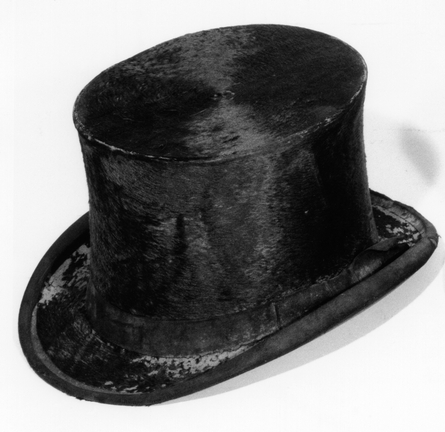
Photo: N/A
More About This Topic
The merchants who purchased beaver pelts were not interested in the fur itself. Rather, they used the under-fur or fiber underlying it. Hat makers "pounded, mashed, stiffened, and rolled" this fiber to make felt. They then used the felt to make hats. By the late 1830s, tastes in fashion changed and hat makers used materials such as silk to make fashionable hats.
Their Own Words
"Beaver has so depreciated in value within the last few years [Ruxton was writing in the 1840s], that trapping has been almost abandoned; the price paid for the skin of this valuable animal having fallen from six and eight dollars per pound to one dollar. Which hardly pays the expenses of traps, animals, and equipment for the hunt. . . . The cause of the great decrease in value of beaver-fur is the substitute which has been found for it in the skins of the fur-seal and nutria—the improved preparation of other skins of little value, such as the hare and rabbit—and, more than all, in the use of silk in the manufacture of hats, which has in a great measure superceded that of beaver. The curse of the trapper is leveled against all the new-fashioned materials of Paris hats. . . . [p. 146]"
Source: George Frederick Ruxton, Wild Life in the Rocky Mountains: A True Tail of Rough Adventure in the Days of the Mexican War, ed. Horace Kephart. New York: Macmillan, 1924.
Mother Beaver With Kits
The beaver has only one mate and the pair produces two to four kits in late May or early June. This pattern is true for almost every year. A mature beaver, usually two or three years old, will weigh from 30 to 60 pounds. Males usually are larger than females.
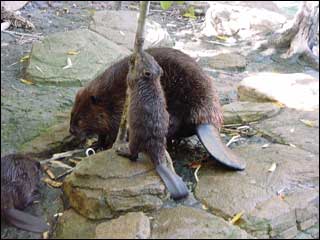
Photo: Minnesota Zoo Website
More About This Topic
Beaver colonies are organized by family units--the mother, father, and their offspring. When the kits are fully grown, they are forced to leave the parent's colony. They may wander for a while, but they often establish their own colonies close to their parent's home pond.
Their Own Words
"The female seldom produces more than three kittens at a birth, but I know an instance where one . . . [had] no less than eleven in her. They live to a considerable age, and I once ate the tail of an old 'man' beaver whose head was perfectly grey with age, and his beard was o fthe same . . . hue. . . . The kittens are as playful as their namesakes of the feline race, and it is highly amusing to see an old one . . . inciting her young to gambol [play] about her, whilst she herself is engaged about some household work [p. 149]."
Source: George Frederick Ruxton, Wild Life in the Rocky Mountains: A True Tail of Rough Adventure in the Days of the Mexican War, ed. Horace Kephart. New York: Macmillan, 1924.
A Beaver Dam
The ideal habitats for the beaver are sluggish streams and small lakes like the one in this photo. Beavers avoid streams that run in rock beds or that are so shallow they dry up in the summer. They build dams that slow the current and create ponds that hold water year-round. The ponds also help protect the beaver, since the entrance to their lodge is under water. Dams also promote aquatic plants such as cattail roots and water lilies, which are the beavers' favorite food in summer.
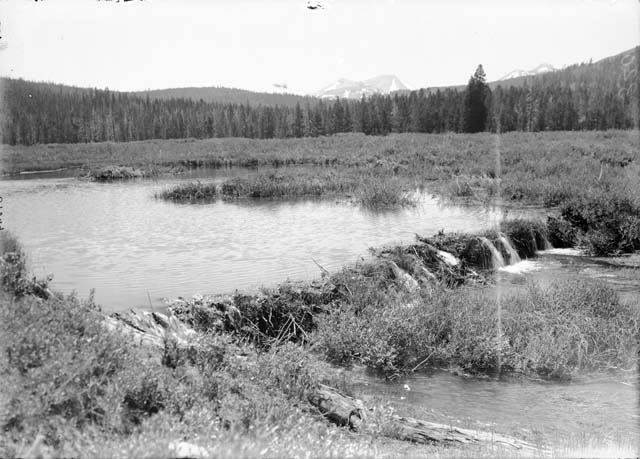
Photo: Denver Public Library, Western History Collection
More About This Topic
According to naturalist Ernest Seton, "the beaver dam is perhaps the most famous of animal undertakings. Everyone knows that it is the beavers' custom to dam up small streams and to build their thatched and mud-plastered log cabins on the margins of the ponds thus made. The dams ensure the makers sufficient depth [of the pond] to protect them from enemies over summer and . . . to make certain that the water will not freeze to the bottom in winter. The dam itself is a vast complicated structure of sticks, stones, roots, mud, and sod. . . . No dam is ever finished, no dam is ever without need of repair. . . [p. 98]."
Source: Ernest T. Seton, Animals: Selected from Life Histories of Northern Animals, (New York: Doubleday, 1926).
Their Own Words
"The habits of the beaver present quite a study to the naturalist, and the are certainly the most [wisely] instinctive of all quadrupeds. Their dams afford a lesson to the engineer . . . . For the purpose of forming dams . . . the beaver often fells a tree eight or ten inches in diameter, throwing it, with the skill of an expert woodsman, in any direction he pleases, always selecting a tree above the stream, in order that the logs may be carried down with it to its destination. The log is then chopped into small lengths, and, pushing them into the water, the beaver steers them to the lodge or dam [p. 148]"
Source: George Frederick Ruxton, Wild Life in the Rocky Mountains: A True Tail of Rough Adventure in the Days of the Mexican War, ed. Horace Kephart. New York: Macmillan, 1924.
A Beaver Lodge
Beavers construct one of two kinds of lodges. One kind is made of branches cemented together with mud. You can see an example in the middle of the beaver pond in the photo. Another kind is a den hollowed out of the stream bank. In either kind of lodge, the entrance is under water.
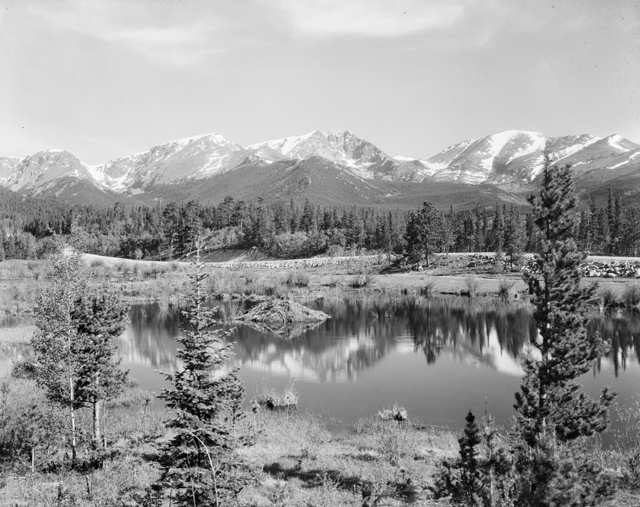
Photo: Denver Public Library, Western History Collection
More About This Topic
With all the effort beavers put into building dams and lodges, they usually do not move their homes or travel very far. With water for protection and wood and food nearby, they have little need to go very far from their home pond. In fact, once a beaver family establishes its colony, it rarely goes farther than one mile from its home pond. This made it easy for hunters to find and trap beaver.
Their Own Words
"The lodge of the beaver is generally excavated in the bank of the stream, the entrance being invariably under water; but not [i]nfrequently, where the banks are flat, the animals construct lodges in the stream itself, of a conical form, of limbs and branches of trees woven together and cemented with mud. . . . With his broad tail, which is twelve to fourteen inches long, and about four in breadth, and covered with a thick scaly skin, the beaver plasters his lodge, thus making it [the tail] perform all the [uses] of a hand [p. 148, 149]"
Source: George Frederick Ruxton, Wild Life in the Rocky Mountains: A True Tail of Rough Adventure in the Days of the Mexican War, ed. Horace Kephart. New York: Macmillan, 1924.
Beaver In A Plains Stream
The waterways chosen by beaver for their homes are usually surrounded by aspen, willow, birch, elder, or cottonwood trees. These trees provide food and wood for building dams and lodges. Beaver also made lodges and dams on plains' rivers and streams, like those in the photo. On the plains, beaver used cottonwood and willow trees for their food and building.
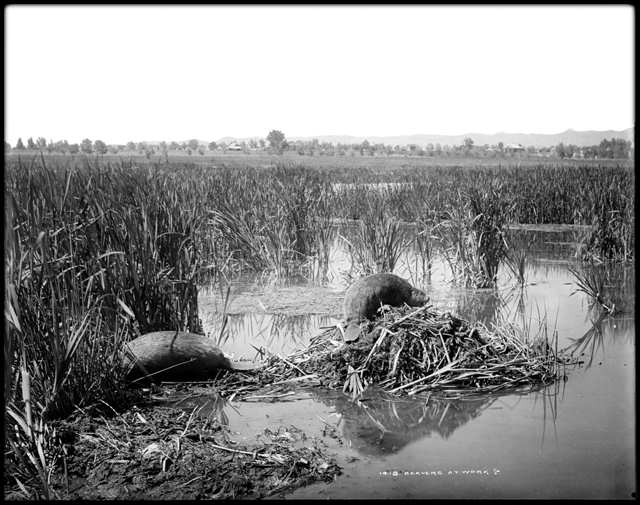
Photo: Denver Public Library, Western History Collection
More About This Topic
Rocky Mountain meadows were ideal places for beaver to build their homes. The beavers' favorite food, aspen trees, grow in these meadows. In the mountains and on the plains, their food sources are found close to streams. Aspen trees, for example, usually grow within 100 feet of a lake or stream.
Their Own Words
"The beaver was once found in every part of North America from Canada to the Gulf of Mexico, but has now gradually retired from the . . . [threats] of civilized man, and is met with only in the far, far west, on the tributaries of the great rivers, and the streams which water the mountain valleys in the great chain of the Rocky Mountains. On the waters of the Platte [River] and Arkansa [River] they are still numerous, and within the last two years have increased considerably in numbers [p. 147]."
Source: George Frederick Ruxton, Wild Life in the Rocky Mountains: A True Tail of Rough Adventure in the Days of the Mexican War, ed. Horace Kephart. New York: Macmillan, 1924.
The Beaver As Wood Worker
The photo shows evidence that beaver have been at work cutting down trees. Cutting down trees is, according to naturalist Ernest Seton, "still on the whole one of the most remarkable of animal undertakings. Two beavers will cut down a three-inch sapling in as many minutes and a small tree in an hour or so. . . . In cutting they gnaw deep parallel grooves round the trunk and then rip out the wood between these grooves in large chips, their broad teeth splitting them out as does a carpenter's chisel."
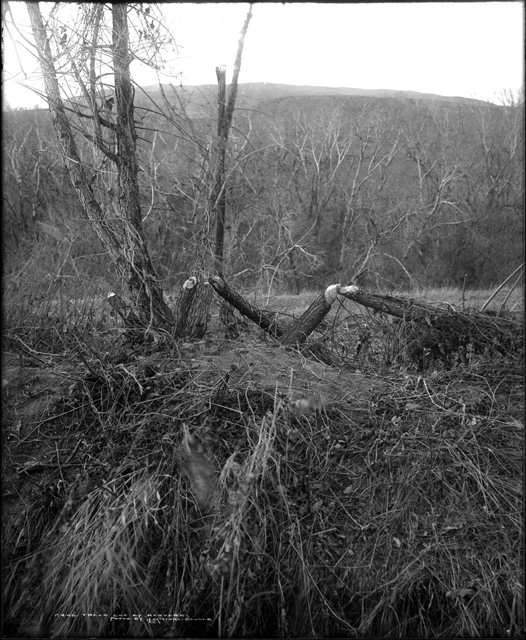
Photo: Denver Public Library, Western History Collection
More About This Topic
According to naturalist Ernest Seton, some experts claimed that beavers gnawed equally all around the trunk of a tree. However, other experts claimed that they gnawed deepest on the side of the tree facing the water. That way, the tree would fall toward the water and make it easier for the beavers to move the log where they wanted it.
Their Own Words
"When but two [beavers] are engaged they work by turns, and alternately stand on the watch, as is the well-known practice of many animals while feeding or at work. When the tree begins to crackle, they desist from cutting, which they afterward continue with caution until it begins to fall, when they plunge into the pond, usually, and wait concealed for a time, as if afraid that the crashing noise of the tree0fall might attract some enemy to the place [p. 99]."
Source: Morgan, quoted in Ernest T. Seton, Animals: Selected from Life Histories of Northern Animals, (New York: Doubleday, 1926).
Beaver Pond And Lodge
Beaver ponds like the one in this photo helped protect beaver from predators. They built lodges with entrances under the water. They also stored food for winter under water.
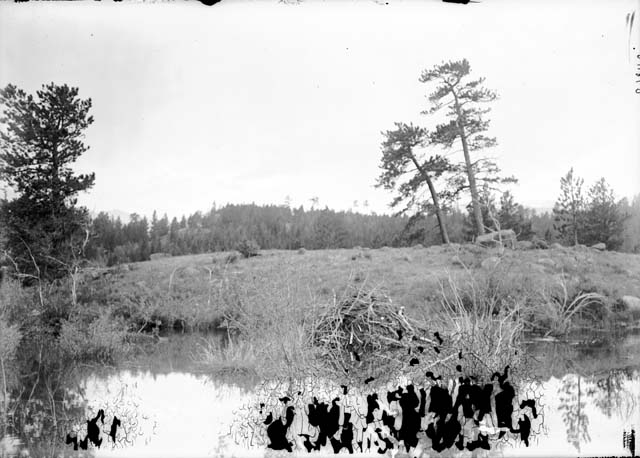
Photo: Denver Public Library, Western History Collection
More About This Topic
The beaver had few natural enemies. The animals that preyed on beaver were the wolverine, the bear, the wolf, the lynx, and the otter. Beaver dams and lodges protected them from most of these predators. "But the greatest of beaver enemies," according to naturalist Ernest Seton, "has undoubtedly been man . . . [who] has desired him both for food and for clothing."
Source: Ernest T. Seton, Animals: Selected from Life Histories of Northern Animals, (New York: Doubleday, 1926), p. 101.
Their Own Words
"Beaver fur was at one time extensively used in the manufacture of hats but has become so rare and valuable that it is now chiefly used for muffs, collars, and trimming. The early prosperity of New York and Canada was based on the beaver . . . which lured on the early explorers and brought here original colonists.; and it was the beaver pelt that, bartered for the manufactured products of the old world, first made life tolerable for . . . [people] in the new [world]."
Source: Ernest T. Seton, Animals: Selected from Life Histories of Northern Animals, (New York: Doubleday, 1926), p. 101-02.

